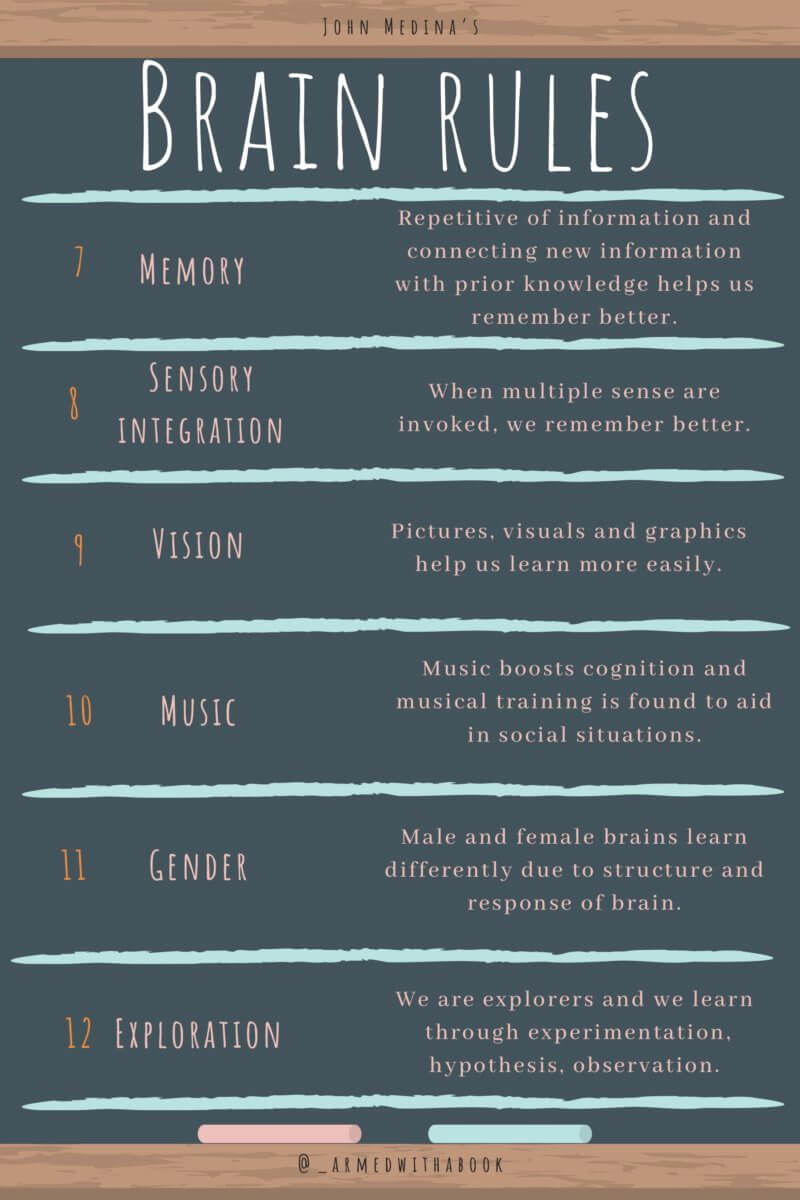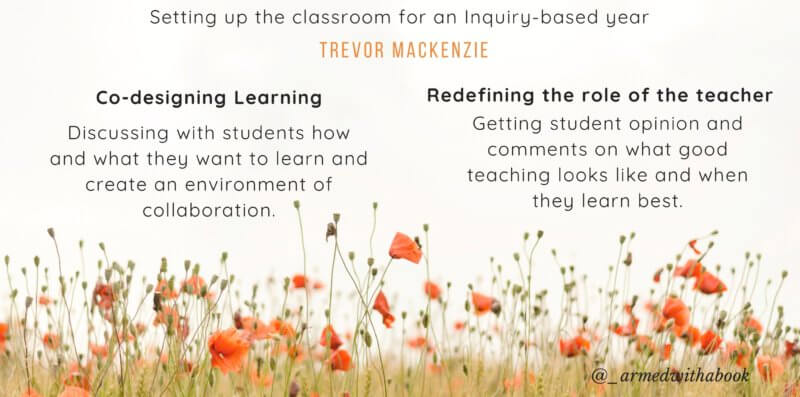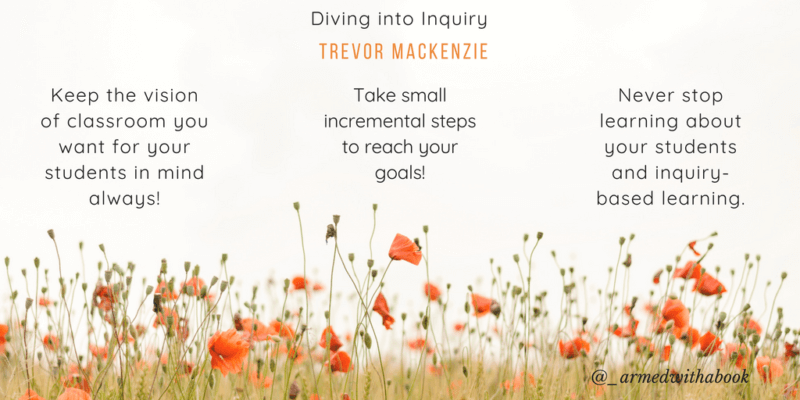 Brain rules are twelve rules proposed by John Medina to help us understand how our brains work and how to use them as effectively as possible. Bringing together research by many brain scientists, the aim of the brain rules is to apply them in our daily lives to learn better, live better and utilize our potential to the fullest.
Brain rules are twelve rules proposed by John Medina to help us understand how our brains work and how to use them as effectively as possible. Bringing together research by many brain scientists, the aim of the brain rules is to apply them in our daily lives to learn better, live better and utilize our potential to the fullest.
Of the twelve brain rules, there are seven that I want to explore in details and incorporate in my classroom. These are Rule 1 (Survival), Rule 2 (Exercise), Rule 5 (Wiring), Rule 6 (Attention), Rule 7 (Memory), Rule 9 (Vision) and Rule 12 (Exploration). I will be focusing on these rules in this article, however, all rules are equally important and I plan to have the following posters around my classroom to provide a summary of all the rules for us to remember as we learn together.


Rule 1: Survival
Our survival instincts are what have helped humans evolve into the society we form today. Medina explains survival as the ability to solve problems, learn from mistakes and create alliances with other people. Thus, collaboration and group work are important for our survival.
The classroom should not be any different. In every walk of life, whether it is the profession or home, people world collaboratively to live in peace and harmony. Thus, teaching team work skills, active listening and developing social intelligence will not only create an environment of trust in the classroom, but also help the students lean on each other and survive the year together.
If someone does not feel safe with a teacher or boss, he or she may not perform as well. If a student feels misunderstood because the teacher cannot connect with the way the student learns, the student may become isolated. (Medina, Brain Rules: Survival)
By building relationships, we can ensure that our students don’t feel isolated and are able to reach out to people in need of help.
Rule 2: Exercise
Starting a class with a quick exercise is a way to refresh the brain. This can be as simple as moving our arms in swimming motions or performing deep breathing exercises. The aim is to get some oxygen to the brain. If there are two classes back to back, a break between them would be good too.
Coding classes can get quite involved and often a mistake I have made while coding (and when I am engrossed in studying) is to forget about the time. I will talk to my students about the Pomodoro technique as well which they can use at home to get them moving between working on tasks. This technique involves working for 25 minutes and then taking a break for 5 minutes. It also a good way to set short smart goals that can be reached. The breaks would also be a good time to stretch and get moving.
Renard (2016) mentions some great games that can be played in class with all age groups of students. I am looking forward to trying out Blind Artist and Jigsaw.
Rule 5: Wiring & Rule 6: Attention
These two rules go hand in hand. By observing my students, I can figure out which learning strategies work best for them and develop my lessons based on their learning profiles. Every child is different and has a different learning style. The key is to find a balance between all learning styles in the classroom. I could think of these in advance and have materials available in different ways (using the concept of Universal Design of Learning). Once I know my students better, I could adapt lessons in class to meet their needs (using the concept of differentiated instruction).
In his book, Dive into Inquiry, Trevor MacKenzie mentions two strategies that he uses to get to know his students better at the beginning of the term. These are: to co-design the syllabus with them and to redefine the role of the teacher by asking them what they think good teaching looks like.

These are great ways to get the know about the way students want to learn and allow them to have a say in how the classroom functions. In the co-design phase, students identify the focus of their learning for the year, while the teacher ensures that the main objectives of the curriculum are met. Assessments, activities, and other strategies that will help in learning are also discussed. This also allows students to voice the different ways they learn and have a say in the what they will learn. For example, a class might identify the need of practical examples and this would become an integral part of the curriculum for the term itself.
The second strategy of redefining the role of the teacher involves opening a feedback loop with the teacher from the very beginning: as a teacher, if I ask the right questions about the why students want to learn as well as the different ways they prefer to learn, I can adapt my teaching according to their needs and interests over time. This way I am gaining knowledge about the wiring and implementing teaching strategies that gain the students’ attention.
I am always looking for ways to get my students actively involved in their education and motivated to be in the classroom, rather than being passively present because they have to be. I recently explored how to get students empowered and enagaged in the classroom and I found the Engagement Taxonomy, as explained in my article, to be a good starting point to rethink lessons. Giving students voice is another example of empowerment. More ideas can also be found in my article on John Spencer and AJ Juliani’s Empower.
Another great resource to understand wiring more generally is the research around Multiple intelligences to better understand the affinities that students might have with some ways of learning over others. I plan to explore this more in subsequent articles, as I read Thomas Armstrong’s Multiple Intelligences in the Classroom.
Rule 7: Memory
By recapping the material often, relating it to present day happenings or relevant day-to-day activities and tasks, students will remember more. Brains possess neuroplasticity which means that they are constantly evolving and the more we use them, the stronger they get. Nowadays, there are a number of technologies available for learning the material and frequently testing oneself on it. Quizlet is one I prefer uses as it not only allows me to make flashcards and tests, I can play games on it, write my answers and check them word to word. It also offers the flexibility to create diagrams for flashcards. Vargas (2011) found that Quizlet helped high school students with disabilities remember social studies concepts better as compared to having a one-on-one tutor.
Rule 9: Vision
Getting content across to students does not have to be just about pages full of words. Expressing material in different ways using pictures, videos, and models allows the brain to make sense of things quickly and remember them better. This is the philosophy of Universal Design for Learning using multiple ways of representation of material. My lectures will use a number of elements: doing online polls in the class, having short discussions, watching videos and listening to what other people have to say about what we are learning and why it is important. I will incorporate Interactive Student Notebooks or journals to give students a place where they can create visuals of their understanding.
Rule 12: Exploration
Schools are a safe environment where students have the opportunity to experiment and evolve at their own pace. I want my classes to be an adventure where the students can each explore their interests to some extent and share their experiences. Inquiry-based learning is a great way to get students to do this.
Inquiry-based learning is a process that students are involved in their learning, create essential questions, investigate widely, and then build new understandings, meaning, and knowledge. That knowledge is new to the students and may be used to answer their essential questions, to develop a solution, or to support a position or point of view. The knowledge is usually presented to others in some sort of public manner and may result in some sort of action. – Alberta Learning (2004)
MacKenzie (2016) gives three pieces of advise to the teacher just starting out in inquiry. These are:

These three considerations are important for teachers who are just starting out with inquiry-based classrooms. The two strategies that MacKenzie mentions (and I have elaborated upon in the previous section) are supplement to building an inquiry mindset of the learners and make them into explorers of their interests and passions.
Genius Hour is another strategy. Melissa White wrote about her successes with the technique here.
Conclusion:
How would you use ( or do you already use ) brain rules to inform your teaching? I would love to hear from you. You can contact me here.
Coming up! I will be writing about Dive into Inquiry as well as Multiple Intelligences theory in the near future.
References:
Alberta Learning (2004). Focus on inquiry. Edmonton, Alberta: Learning Resources Centre.
Armstrong, T. (2014). Multiple intelligences in the classroom. Ascd.
MacKenzie, T. (2016). Dive into inquiry: Amplify learning and empower student voice. EdTechTeam Press.
Renard (October 2016). 15 Fun classroom energizers for students. Retrieved from: https://www.bookwidgets.com/blog/2016/10/15-fun-classroom-energizers-for-students
Vargas, J. M. (2011). Modern learning: Quizlet in the social studies classroom (Graduate Thesis, Wichita State University).
Featured image credit: darkday. on Visualhunt.com / CC BY

Be First to Comment